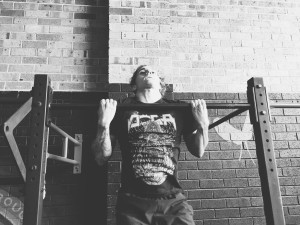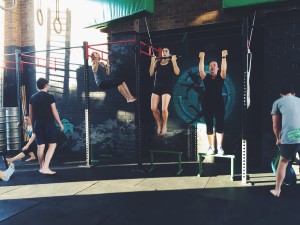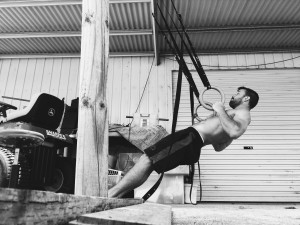Unlocking The Pull Up
The Pull up. The king of upper body exercises according to many.
Then of course there is its slightly friendlier and more accessible younger cousin, the Chin up
Firstly, some definitions:
Chin up = supinated grip (underhand)
Pull up = pronated grip (overhand)
Eccentric = the lengthening phase of a movement (like lowering yourself from the top of a pull up)
Concentric = the shortening phase of a movement (like pulling up to a bar)

The Pull up is king because it targets the most amount of muscle in the torso and arms and also has the largest carryover to every other thing we humans can do.
Here at the Outpost we have cultivated a community of people who are constantly striving for improvement in their overall strength. We ‘push’ the pull up (and chin up, ring row, rope pulls etc.) onto our people all the time because we want them to possess this ability. Needless to say, we see it as an essential skill to have.
This here is a guide you can use to help you achieve your own pull up.
A LOOK AT THE DIFFERENT PROGRESSIONS
Something Joey and Tee learned from Ido Portal was the idea of breaking movements down into ‘Landmarks’, in order to provide a quasi-linear path of progression so that one can see where they are currently at and where they are headed.
The JB Pull Up landmarks are:
- ring row
- ring chin up
- chest to bar isometric hold
- eccentric chin up
- chin up
- pull up
1. Ring Row
Position: grip the rings with feet on the floor at around hip width and the body hanging underneath the rings.
Action: start with the elbows fully extended and the scapula neutral. Initiate the pull by retracting the scapula and then pulling the elbows into full flexion. The elbows stay alongside the torso and the rings must contact the chest at the top of the pull. Rest slowly into the bottom position.
Goals: 5 sets of 5 reps at a tempo of 40X1, resting 2mins between sets. Once easy, move the feet slightly forward to position the body further underneath the rings. The most challenging position is with the rings hanging vertically and the body horizontal, floating just off the floor when the arms are straight. Work up to this.
2. Ring Chin Up
Position: similar to the row, but the rings now hang vertically and the feet will be positioned just in front of the rings and up
on the toes.
Action: start with elbows fully extended and palms pronated, retract and depress the scapula, the flex the elbow and pull the rings to chest while supinating the palms. Rings must contact the chest at the top position. The idea here is to keep the rings hanging vertically. The trick is keeping minimal bodyweight through the feet, they should only be used as little as possible to support the movement.
Goals: 5 sets of 5 reps at a tempo of 40X1, resting 2mins between sets.
3. Chest to Bar Isometric Hold
Position: Grip a pull up bar with a supinated shoulder width grip
Action: Jump up to the bar and pull the chest to the bar and hold this position. The scapula must be in full retraction and depression with the chest staying connected to the bar for the entire set. Let the body hang loosely under the bar. It may be useful to use a box to allow you to get into position without having to expend all of your energy before its even started. A spotter can also help with a gentle push up against the mid back. Remember, you MUST keep the scapula in full retraction in order to get that chest connected to the bar.
Goals: 5-10 sets of 10-20s holds, resting 2-3mins between sets. These can also be used as accessory work after some ring rows, chins, chin ups or pull ups.
4. Eccentric Chin Up
Position: Same as chest to bar
Action: Start in the same way as a chest to bar with the scapula fully retracted, and then with control slowly lower the body down into a passive hang. From there reset back to the chest to bar and go again for the next rep. The action must be fully controlled throughout the entire movement. The whole eccentric phase should be at a consistent and controlled tempo. Remember to follow the order of elbow extension and THEN scapula elevation as you descend into the passive hang.
Goals: 5 sets of 2-5 reps, resting 2-3mins between sets. The duration of the eccentric can be manipulated but as a general rule 5seconds is a good place to start. If increasing the duration (anywhere up to 30seconds is reasonable) there should be a corresponding decrease in the reps. ie. 5 sets of 1 x 30s rep / 5 sets 5 x 5s rep

5. Chin Up
Position: Same as the Chest to Bar
Action: start in a passive hang position with the scapula completely relaxed. Initiate the pull by first depressing and then retracting the scapula, then flexing the elbows and pulling the chest to the bar. Reset with control back into the passive hang making sure to reverse the order on the way down (first extend the elbows and then the scapula)
Goals: 5 sets of 2-5 reps at a tempo of 41X1, resting 2-3mins between sets
6. Pull Up
Position: Same as above but with a pronated grip (overhand, but you should know this terminology by now!)
Action: start in a passive hang position with the scapula completely relaxed. Initiate the pull by first depressing and then retracting the scapula, then flexing the elbows and pulling the chest to the bar. Reset with control back into the passive hang making sure to reverse the order on the way down (first extend the elbows and then the scapula). The top position of a pull up is much harder than a chin up, so connecting that chest to bar may be a little challenging at first. As a minimum standard, the middle of the neck must get to the height of the bar with the goal of eventually developing the strength to get the chest to the bar.
Goals: 5 sets of 2-5 reps at a tempo of 41X1, resting 2-3mins between sets
HOW OFTEN SHOULD I DO THESE?
In order to develop a pull up a minimum of two workouts per week is necessary. For some people a third workout may be suitable, but certainly no less than two. These are big movements that use a lot of energy and muscle and as such there will be some associated soreness and thus recovery needed. Allow 2-3 days in between heavy pull up (or push up) workouts. make sure you are doing all the right things in terms of recovery too – adequate rest, protein, water, movement etc.
WHICH LANDMARK SHOULD I USE?
The one that you CAN use. For most beginners the ring row will be the first port of call. From there the goal should be to travel through the other landmarks as efficiently as possible, however not without spending enough time with each landmark in order to completely ‘suck all the nutrients out of it’. Many an enthusiastic beginner strength athlete has stunted (or regressed) their progress by rushing too fast into landmarks that are beyond their ability.
I have taken women ranging in age from 19-45 with ZERO pulling strength to one full chin up in under 10 months. I know for a fact it can be achieved in even less time than that. Get to work.
YOU NOTICE THAT I SPECIFICALLY MENTION WOMEN
The pull up is an evasive movement for many people, and particularly women. There are many reasons for this, but boiled down there are a few key truths:
- Women generally have less upper body strength and muscle mass than men do (that said, they do have MORE strength and muscle mass than men in the hips! the wonders of bearing children)
- Conventional fitness doesn’t market such things to women. Instead it markets Bodypump classes, treadmills, pilates, yoga etc. All great things in their own rite i’m sure, but shithouse when it comes to developing real upper body strength.
- The majority of Coaches or PT’s out there don’t know how to teach this stuff, and so they get you working on lat-pulldowns, bicep curls and band-assisted pull ups in the hope that one day it will magically appear.
In addition to this, we have a small army of dedicated women that train with us here at the Outpost. These women are driven to achieving such things as a chin up, muscle up, rope climb etc. We very much encourage and expect that they strive for such gains in their training.
SOME USEFUL ASSISTANCE EXERCISES
- Cuban rotations
- active hangs
- arched active hangs
- reverse bicep curls
I will dive deeper into these in the coming week, so stay tuned..
I hope this provides some help for you good humans out there, and i hope you get a chin up OR pull up of your own very soon. Make sure to comment, like repost, whatever in order to spread the good word and help others make some real gains.
If you are having trouble with your own training and want to get in touch just drop me a line on 0422 412 533 or joey@junglebrothers.com
Happy gains!
Joey
*We give much credit to Ido Portal for this material. I personally study his methods closely and as a business we draw much inspiration from his work. We strongly recommend that if you get the chance to attend one of his workshops you should! You can learn more about him here.

